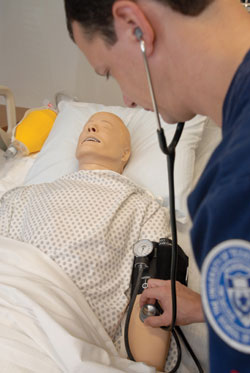FORE
THOUGHT
This hospital is smart all right, and so much more

Mr. Myers had a history of heart problems. His chest hurt as he lay in an ICU bed surrounded by five nurses.
“How are you feeling, Mr. Myers?” a nurse asks.
Silence.
“He flatlined! He has no pulse.”
The nurses begin bagging (a process used to aid breathing) and using a defibrillator to re-establish a heartbeat. Several shocks later, Mr. Myers is stable. Then he speaks.
“Hi, guys, it’s Aaron.”
Aaron is Clinical Professor Aaron Mitschke, who orchestrated this learning scenario from the control room of the School of Nursing’s Smart Hospital. The nurses are actually senior nursing students, and Mr. Myers is one of the facility’s 30 full-body patient simulators. Mitschke speaks through the manikin and controls its vital signs using advanced computer software.
A few minutes earlier, Mitschke put another group of students through a similar situation with a patient they called Ms. Gonzalez. During the simulations, one group watches the other from a high-tech classroom in a different wing of the 13,000-square-foot hospital that opened in August.
After the hands-on scenarios, it’s instant replay time.
Mitschke leads the students into the debriefing room, where they watch videos of what happened. He tells them what they did right and what needs improvement. With Mr. Myers, the students should have shocked first and bagged later.
They’ll get it right next time. More importantly, they’ll know what to do a year from now as registered nurses working in real hospitals. But right now the Smart Hospital is reality, and it’s remarkably close to an actual clinical setting.
In addition to manikins that can progress from birth to death, the hospital boasts a seven-bed emergency services department, four-bed ICU, two-bed neonatal ICU, three-bed pediatric unit, four-bed medical-surgical unit, two labor and delivery suites, a team training room, and a family health and wellness room.
In August, transport teams from Children’s Medical Center Dallas used the Smart Hospital for re-credentialing. I sat in the control room while a scenario played out involving a child who had fallen off a horse. Listening through headphones and watching the three camera views on my monitor, I could feel the intensity in the room.
“It’s very realistic,” says simulation coordinator Mindi Anderson of the one-of-a-kind facility. “Once you see the monitors and hear the patient, you want to do something for him.”
Just like real life.
![]()
— Mark Permenter
Other Stories
Leadership investments
Corporate gifts establish Goolsby Academy scholarship, professorship
Mavericks Personified: Tommy Le Noir
Alumnus brings crime-solving savvy to reality series
The speed of life
Professors’ book examines fast-paced families
Former stars join athletics hall
Ceremony also honors men’s track and field teams
Alumni Association awards scholarships, hosts programs
Search
Contact Us
Office of University Publications
502 S. Cooper St.279 Fine Arts Building
Box 19647
Arlington, TX 76019-0647
